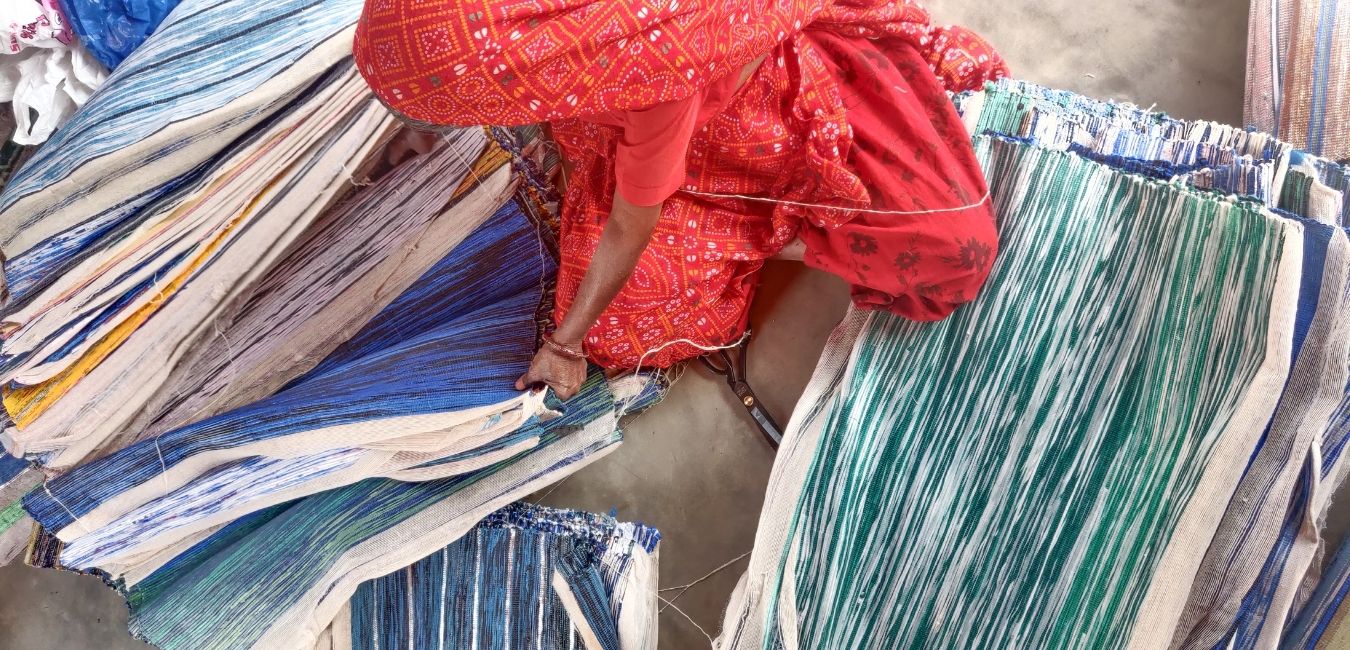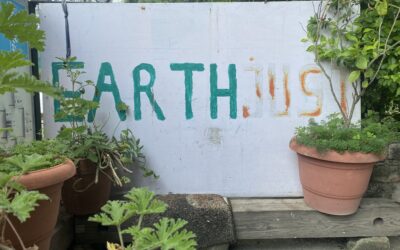I am working with Khamir on creating a craft curriculum and delivering it in schools. Our vision is to create an education system that is not only rooted in mainstream knowledge but also reveres the traditional knowledge systems that have thrived in India for centuries. By engaging children in hands-on activities, we aim to make education more interactive, contextual, and stimulating. We also seek to expose them to the broader economic and societal structures that these crafts encompass. All this will empower them to navigate their lives better.
The Project
Khamir has been actively involved in education for a long time. The organisation has facilitated learning experiences, invited students and collaborated with various educational institutes specialising in design, architecture, heritage management, and social work. Khamir serves as a resource centre for craft communities and for those who wish to collaborate and learn from them.
The craft curriculum project tries to do things differently. Unlike the general exposure to the world of crafts that Khamir has traditionally provided, this project delves deeper. It introducing people to the crafts of Kachchh, offering an in-depth view of the processes and communities involved. Additionally, it also helps understand how artisans create what they create, why and for whom.
Taking A Step Further
With this project, our goal is to facilitate holistic exploration among children. They would understand how the products are made, the process involved, and the significance of these processes. They also learn about the communities engaged in these crafts, their history and the related social dynamics. Such exposure lays a strong foundation for learning. Through hands-on engagement and interaction with artisans, children hear stories and develop an understanding of crafts from various perspectives – anthropological, sociological, and cultural.
Core Beliefs of Khamir
The project reflects Khamir’s core beliefs:
- Artisans as Bearers of Knowledge: Khamir recognizes the immense knowledge and complex understanding that the artisans possess. Having worked with them for more than two decades now, we see artisans as custodians of traditional wisdom.
- Value in Traditional Knowledge Systems: Working with artisans and studying their economics exposes us to their cultural, traditional, and belief systems deeply rooted in values. In the rapidly changing times, understanding these systems is crucial for building meaningful connections with the world and its inhabitants.
- Crafts as a Medium of Education: It can open up dialogue and learning across various disciplines, facilitating a broader understanding of numerous phenomena and principles.

Based on this, we believe that the curriculum will enhance the learning experience of a child. However, it will take time to develop. In the last 10 months of my involvement with the project, I have faced multiple challenges and constant need to reorient and re-design it.
Furthermore, crafts are not just about techniques and products; they are intertwined with people’s lives and cultures. Questions like “What is the original purpose of the craft?”, “How is it connected to us as human beings?”, and “How do crafts go beyond being skills and occupations?” become central to the learning process.
Building The Curriculum
Building a curriculum at the intersection of crafts and education is a complex task. It requires knowing multiple things including the ecosystem, teaching methodologies, and learning outcomes. Our work can be classified into five broad categories:
- Research and Sense-making: We speak with artisans, read books, visit craft villages, and continuously refine our approach of craft practices. We also relook at how they can be taught. This helps improve planning and facilitation during sessions. This stage involves collecting and processing a lot of information.
- Building Familiarity: In any craft, understanding the materials, techniques and process of arriving at the final product is essential. Before taking these practices to the classroom, we engage with it to gain relevant insights beyond theory. It helps build empathy with someone new to a craft, and how we can guide them through it.
- Planning Curriculum and Sessions: We design modules, session plans, and curricular outlines that make the learning experience such that children engage in the activities as well as consider the overall goal of holistic exploration.
- Facilitation and Implementation of Sessions: This involves managing logistics and conducting sessions in schools and community centres.
- Reviewing and Analyzing: Reflection on sessions helps us understand their effectiveness and guide redesign.
As we wrap up the 2022-23 academic year, we reflect on our successes and challenges. We go over all the sessions conducted throughout the year to understand engagement levels, and identify patterns and areas for improvement. One major gap identified was that of facilitation – the way we create a learning environment with children. To improve this, we took part in multiple training sessions and workshops on facilitation.
Apart from that, there was an elephant in the room – lack of participatory approach. To listen from those who will be affected by it.
Incorporating A Participatory Approach
Participatory development, at its core, places faith in the ability of people’s collective efforts for common good (Ostrom, 2015). It is adaptable and flexible, being an approach rather than a rigid framework. It’s a way one chooses to work. For Khamir, this means actively involving artisans, teachers, students, and other community members in the design and implementation of the curriculum.
People are more likely to act on what they have freely decided to do than on what others have tried to persuade them to do; through participation in the process of thinking, deciding, and planning, they will acquire more confidence and competence as persons.
Batten & Batten, 1967; Tropman, 1968
Mobilise Mobilise Mobilise
Here are a few practical examples of how participatory approach played a significant role in the project:
- Artisan Involvement: We actively involved artisans in the planning phase, where they contributed ideas and insights on how to best represent their crafts in the curriculum. Their involvement continued through the implementation phase where they conducted workshops, imparted traditional knowledge and shared their stories with the students.
- Teacher Engagement: Teachers were trained in the nuances of the crafts, and they actively contributed to the curriculum development. They also helped in facilitating the sessions, ensuring that the learning objectives were in line with the students’ existing educational framework.
- Reaching The Parents: We went door to door to meet the parents and talked to them about the project that will directly benefit their children. Meeting them also helped the team in building a rapport and getting their buy-in.
- Student Feedback Loop: Students were not just passive recipients. The team encouraged them to give feedback, ask questions, and share their interpretations of the crafts. This feedback loop allowed the curriculum to evolve and remain dynamic and relevant. The students need to be placed at the centre of the circle shown above.
- Community Integration: The larger community was made aware of the project and invited to contribute. Local materials and resources were used, and there was an emphasis on understanding the role of crafts in the socio-economic fabric of the community.
Conclusion
As Khamir’s project progresses, we continue to learn and grow. The journey has been enriching for everyone involved, as we endeavor to keep the rich craft traditions alive through education. Through a participatory approach, we are forging a bond between the past and the present, and between the crafts and the community.
In conclusion, this experience has made it abundantly clear that education is not just about imparting knowledge but creating environments in which learning can flourish. By integrating craft into the curriculum, we’re not only educating, but also nurturing a sense of identity, pride, inclusion, and belonging among the students and the community.
And as the children of today become the future custodians of the crafts, my job is not just to teach them and design sessions but to also arrange for a table and pull some chairs.
References:
- Developing Rights: The UN Declaration on the Right to Development
- A Brief History of Participatory Community Development Approaches and Practices
Featured image for representation purpose only. Contributed by Annabelle, a 2020 fellow.




0 Comments